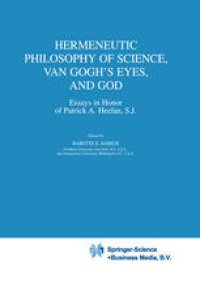
Ebook: Hermeneutic Philosophy of Science, Van Gogh’s Eyes, and God: Essays in Honor of Patrick A. Heelan, S.J.
- Tags: Philosophy of Science, Phenomenology, Modern Philosophy, Aesthetics, Religious Studies
- Series: Boston Studies in the Philosophy and History of Science 225
- Year: 2002
- Publisher: Springer Netherlands
- Edition: 1
- Language: English
- pdf
perceptual essences that can be rendered directly manifest in perception with the help of theoretically structured instruments serving as 'readable technologies'. " Scientific knowledge should thus be understood as an extension of "unassisted" perception. A perceptual fact has an outer horizon "which separates it from the ground on which it appears," and an inner horizon "composed of a multiplicity of possible perceptual profiles organized by an invariant essence. " The perceiving subject can "bring forth a representative sample of the profiles in question," occasionally by making use of certain technological processes, which are themselves subject to interpretation in terms of theoretical representations. The theoretical entities described in these representations are not "simply detected thanks to an inferential operation, but rather, they are directly perceived. " It follows from this that the correspondence between the "manifest image" and the "scientific image" is not done one-to-one, but by a "many-to-one or one-to many application between contextually defined perceptual objects within contexts that are mutually incompatible but complementary. " This should not, however, be understood as a form of conventionalism, nor as a form of "cultural relativism. " Pre comprehension, which guides interpretation imposes strict limits to the descriptive categories which can be used and to the manner in which they can be linked to appropriate empirical objects. The author applies his hermeneutic principles to the study of visual perception. (In fact this question is treated in the first part of the book.
This richly textured book bridges analytic and hermeneutic and phenomenological philosophy of science, featuring unique resources for students of the philosophy and history of quantum mechanics and the Copenhagen Interpretation, cognitive theory and the psychology of perception, the history and philosophy of art, and the pragmatic and historical relationships between religion and science. Of special interest is the new technology of variational graphic representations with the insights (and mathematical apparatus) of Patrick Heelan's work on the perception of space and the history of art, particularly the work of Cézanne and Van Gogh.
This book will interest students of the scientific philosophies of Heisenberg and Bohr, Wittgenstein (on science - Hertz - and on religion - Rush Rhees), as well as the social histories of Thomas Kuhn and Ludwig Fleck, and the philosophical insights of Husserl, Heidegger, Merleau-Ponty, Lacan, Foucault, and including pragmatism and the contemporary Thomism of Bernard Longeran.